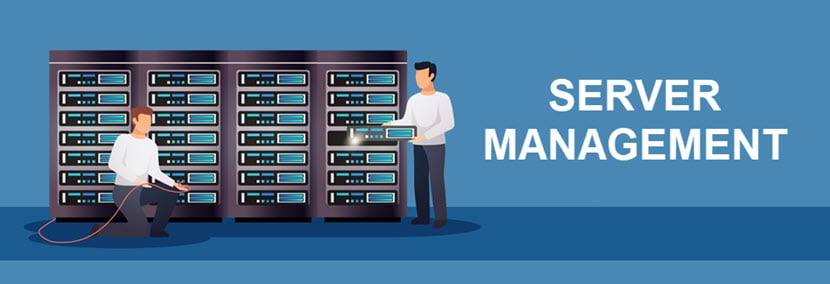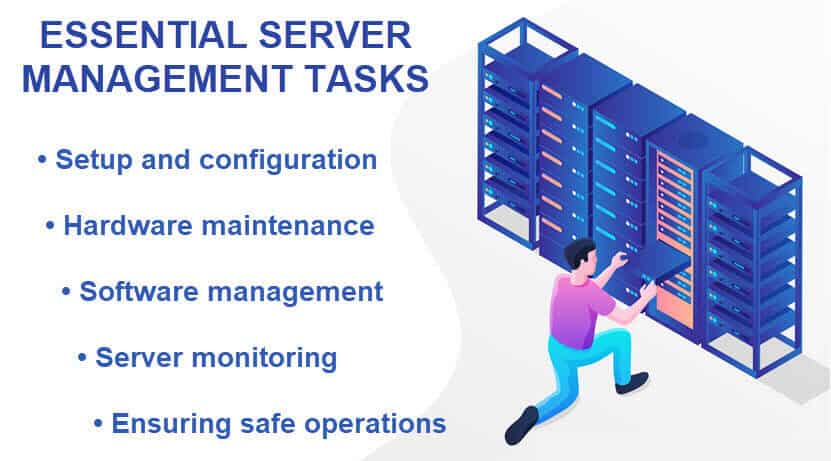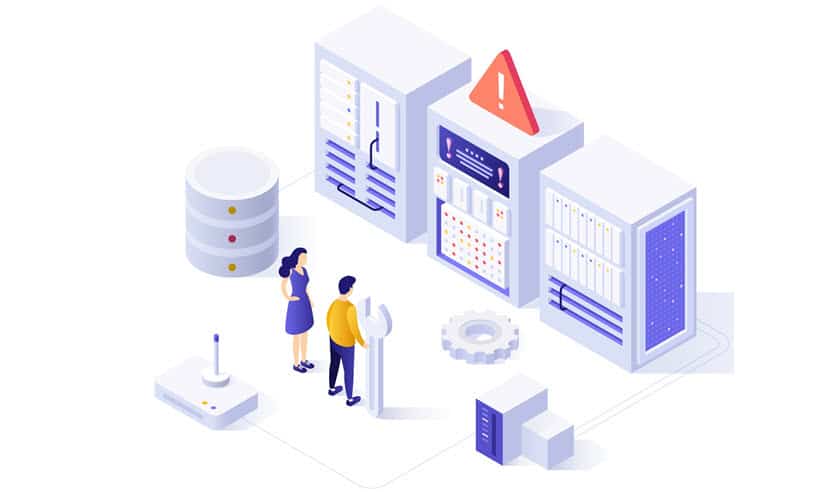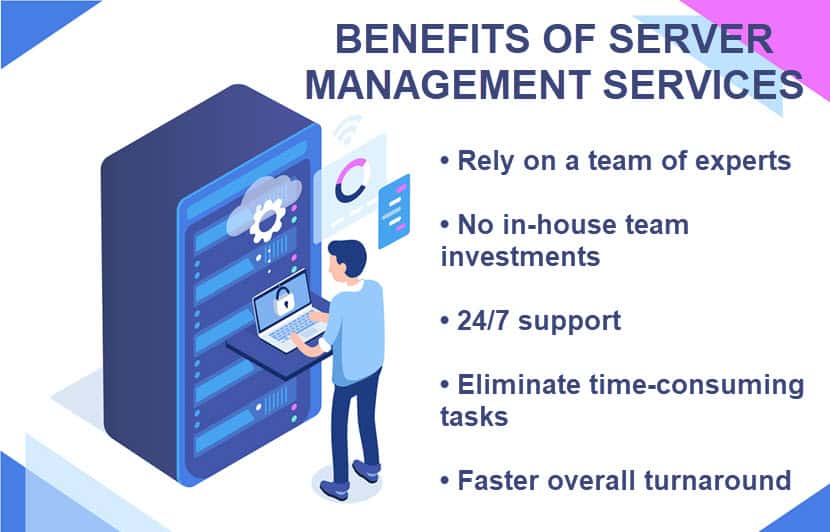What is Server Management?
Servers are essential to most IT functions, including data storage, web hosting, emails, and app functionalities. Due to their pivotal role, servers require continual management and maintenance to ensure longevity, efficiency, and adequate security.
This article is a decision maker’s guide to server management. Read on to learn about the main aspects of server management and see how SMBs and enterprises keep their data storages healthy and efficient.

Server Management Definition
Server management is the process of administering a server to ensure optimal and safe performance. The main objective of this IT activity is to keep the server and its associated systems in a desired, consistent state.
Managing a server requires various administrative and maintenance tasks. The staff needs to:
- Minimize server slowdowns and downtime.
- Maintain server hardware and address technical problems.
- Keep software up to date.
- Design and implement system structures.
- Monitor apps running on the server by tracking status, uptime, and recurring issues.
- Perform troubleshooting.
- Run fault management tests.
- Implement robust backup strategies and cybersecurity solutions.
- Monitor server traffic for suspicious activity.
- Ensure servers keep up with requirements as business needs evolve.
Depending on the size of the IT setup, server management can be the task of a single admin or an entire team. While an admin can operate on an in-house level, companies often choose to outsource server management. Different providers offer different services, so choose a vendor that meets your requirements.
Want to take the operational burden off your team? Our managed services offer the most well-rounded and flexible server management on the market.
Both servers within data centers and in the cloud require some form of management. The most common types of servers a team can manage are:
- FTP (File Transfer Protocol) servers that handle to-and-fro data transfers between a server and devices.
- Web servers that host websites.
- Virtual servers that run on VMs.
- Proxy servers that initiate and manage communication between a client and an external server.
- Database servers that store large amounts of data.
- Application servers that store and run web apps and plug-ins.
Our comparison of web and application servers outlines the differences and similarities between the two common server types.
Server Management Tasks
The goal of server management is to improve efficiency and performance while ensuring the safety of IT operations. Below are the main tasks a team needs to account for in their server management strategy.

Setup and Configuration
Setting up the server and configuring software, add-ons, and functionalities is a core aspect of server management.
The setup process varies for different server types. An admin must know how to set up a server with physical components and one running on a VM in a third-party cloud.
The configuration is also not the same for all server types and use cases. For example, a server that hosts a blog needs a different platform than a website that offers e-commerce services. Configuring a typical Linux server requires an admin to go through the following steps:
- Set up user configuration (credentials, privileges, access levels, etc.).
- Set up network configuration and communications.
- Work on package management.
- Update the installation and patch potential vulnerabilities.
- Prevent clock drift via NTP configuration.
- Set up a firewall and iptables to minimize external footprint.
- Set up SSH to protect remote sessions.
- Work on daemon configuration to reduce the attack surface.
- Protect the kernel and apps with SELinux.
- Set up a logging system.
Business needs dictate server configuration. An admin must review all business, hosting, and server requirements to determine the correct settings and specifications.
Precise capacity planning is vital to server management. When setting up hardware, an admin must carefully consider the required specifications. Excess storage and processing ensure good performance but can also lead to unnecessary upfront costs and energy usage.
Hardware Management
Keeping hardware in good health is a vital aspect of in-house server management. Without reliable hardware, all systems and operations that rely on the server can run into issues. A server admin must monitor three primary hardware components:
- The central processing unit (CPU): Overusing the CPU can lead to various problems. A CPU running close to 100% utilization overtaxes the device, leaves no capacity for extra tasks, and slows down the server. Admins typically upgrade the chip, add more CPUs, or stop unnecessary programs to handle an overused CPU.
- Random-access memory (RAM): RAM is a server’s working memory that operates faster than a hard drive. The more RAM a server has, the better its potential performance. Admins must monitor RAM usage and determine when the system requires more running memory.
- Hard drive: The hard drive acts as a server’s permanent storage for programs, data, and backups. Performance can take a hit when a hard drive works at maximum capacity, so admins must add drives or delete unnecessary data when disks fill up.
Monitoring the server’s temperature also falls under hardware management. Admins typically rely on wired thermometers and cooling fans to prevent devices from overheating.
If you host your servers in the cloud, the staff does not need to worry about hardware maintenance. The only exception is if you host a server on a VM running on an in-house private cloud. In that case, you need an admin to keep the dedicated hardware in good shape.

Software Management
Just like hardware, server software requires regular monitoring and maintenance. An admin must:
- Understand software dependencies within the infrastructure.
- Keep software, firmware, and the operating system up to date with the latest patches.
- Know how to search for software vulnerabilities that could lead to a potential data breach.
- Uninstall old and inactive programs the team no longer uses.
- Ensure developers constantly update the code to remove bugs and weaknesses.
Most companies use Linux servers as this open-source platform is the most economical and secure OS for servers. Companies that rely on Windows servers typically have apps that only work on that operating system. Whatever the OS, the admin needs to keep the system up to date with the latest patches to prevent cyberattacks.
Unsure what OS to use on your server? Our head-to-head comparison of Linux and Windows servers outlines the factors you need to make an informed decision.
Server Monitoring
Constant monitoring helps an admin keep a server safe and working at peak performance. Metric tracking and analysis allow the team to identify and prevent issues before they affect business-critical systems.
Monitoring hardware is vital. An admin needs live data evaluation that provides real-time feedback in terms of:
- Processor usage.
- Memory utilization.
- Disk space availability.
- Server room temperature.
Hardware monitoring aside, an admin should monitor processes running on the server and track how much resources each process consumes. The team must also keep track of the following parameters to guarantee top performance:
- Page load time.
- Database lags.
- Service up-time.
Robust server management also requires reviewing access logs, unusual traffic spikes, and unauthorized login attempts. Odd logins and traffic behavior are clear signs of possible intrusion attempts.
Alerts are a mandatory aspect of robust server monitoring. An admin typically sets benchmarks for heavy traffic, poor disk usage, or overheating. If the server breaches a specific threshold, a notification via SMS or email alerts the staff.
Our article about server monitoring tools analyzes the best options on the market and helps you pick the right tool for your IT team.
Server Security
Maintaining a secure network also falls under server management. While security policies and requirements differ between industries, an average admin needs to:
- Install, optimize, use, and keep an antivirus solution up to date.
- Set up a firewall to filter unauthorized traffic.
- Create a credentials policy that ensures users have strong passwords.
- Run regular vulnerability assessments.
- Initiate and participate in penetration testing.
- Set up access control software and enforce zero-trust security.
- Use encryption to protect sensitive data.
- Choose and implement SIEM tools.
- Promote cybersecurity best practices across different teams and departments.
Our article about server security teaches simple and effective ways to boost your server’s safety.
Backup and Recovery
Regular data backups are essential to the security of servers and the information they host. Backups can either run on an in-house physical infrastructure or in the cloud. In both scenarios, an admin should use an immutable backup to ensure data remains safe even if intruders breach the server.
Besides using an immutable backup, other good practices when setting up server backups is to:
- Back up data multiple times a day.
- Use network segmentation to separate the backup from other systems.
- Provide limited access to the backup.
- Limit editing permissions.
- Regularly scan backups for malicious data.
- Optimize RTO (Recovery Time Objective) and RPO (Recovery Point Objective) to ensure a smooth user experience during backup.
The server’s power supply also needs a backup. A reserve power supply ensures you do not lose data or experience downtime in case of a power outage.
Who Needs Server Management?
Every business that owns or relies on a server requires server management. From one-person operations to an enterprise with a stacked data center, server management is not optional. The only question is if you can self-manage your equipment or hire a third party to do the job.
If you have the personnel with the proper skill set, managing servers in-house offers total control over the environment. When the team lacks the experience, outsourcing server management makes more sense than investing in training and new employees.
If you choose the in-house option, you need a server management tool to automate processes and provide insights into the equipment. Not all solutions offer the same features, however, so consider the following factors when looking for the right tool:
- Ensure the solution can work with all server types and apps in your stack.
- Look for a program with an intuitive UI and visualization capabilities that simplify advanced tasks.
- The software should allow the team to set thresholds and custom alerts.
- The tool should provide an abundance of detailed, thorough data about the state of the server.
- Consider how much training the staff will require before they start using the tool.
- Look for a solution that offers rich automation features that streamline workflow and help employees save time.
Some companies choose to rely on a mix of in-house management and outsourcing. A popular option is to have the in-house staff handle software and hardware management while an outsourced expert works on server security and backups.
Learn about server automation, how to achieve it and how your business can benefit from it.
Advantages of Server Management Services

Choosing to hire a service provider to drive your server management has many benefits. Here are the most notable reasons why outsourcing a server admin is a good investment:
- Top-tier experts: Providers specialize in server management, so third-party admins have more experience than an average in-house team.
- Lower operational costs: Most server management services are subscription-based. An average monthly or yearly fee is far less expensive than investing in an in-house team of full-time personnel.
- Reliable support: Most service providers offer 24/7 support to their customers. On-call support with guaranteed response times is ideal for preventing downtime.
- Eliminate time-consuming tasks: Managing a server requires consistent monitoring, optimization, and analysis. Assigning these time-consuming duties to a vendor allows your staff to focus on more impactful tasks.
- Faster turnaround: If you side with the right partner, the turnaround time for server setups and updates is always quick.
Not sure what type of server is the right fit for your use case? Our comparison of bare metal cloud and dedicated servers weighs the two popular options.
Server Management is Not Optional
Effective server management prevents downtime, security breaches, and performance issues. Failing to set up a proper strategy can lead to devastating consequences, so either train your team to perform server maintenance or hire experts to ensure your operations stay smooth and efficient.